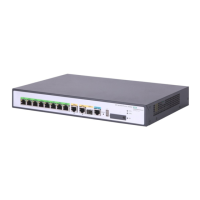354
Item Descri
tion
Source
Address/Wildcard
• Characteristics of Traffic—Identifies traffic to be protected based on the source
address/wildcard and destination address/wildcard specified.
• Designated by Remote Gateway—The remote gateway determines the data to be
protected.
IMPORTANT:
• To make sure SAs can be set up, configure the source address/wildcard on one
peer as the destination address/wildcard on the other, and the destination
address/wildcard on one peer as the source address/wildcard on the other. If
you do not configure the parameters this way, SAs can be set up only when the IP
addresses configured on one peer are subsets of those configured on the other
and the peer with the narrower address range initiates SA negotiation.
• If the data range is designated by the remote gateway, the local peer cannot
initiate a negotiation.
Destination
Address/Wildcard
Reverse Route Injection
Enable or disable IPsec RRI. When enabling IPsec RRI, you can specify a next hop
and change the preference of the static routes.
After an outbound IPsec SA is created, IPsec RRI automatically creates a static route
to the peer private network. You do not have to manually configure the static route.
IMPORTANT:
• If you enable IPsec RRI and do not configure the static route, the SA negotiation
must be initiated by the remote gateway.
• IPsec RRI creates static routes when IPsec SAs are set up, and delete the static
routes when the IPsec SAs are deleted.
• To view the static routes created by IPsec RRI, select Advanced > Route Setup
[Summary] from the navigation tree.
Next Hop
Specify a next hop for the static routes.
If you do not specify any next hop, the remote tunnel endpoint’s address learned
during IPsec SA negotiation is used.
Priority
Change the preference of the static routes.
Change the route preference for equal-cost multipath (ECMP) routing or route
backup. If multiple routes to the same destination have the same preference, traffic is
balanced among them. If multiple routes to the same destination have different
preference values, the route with the highest preference forwards traffic and all other
routes are backup routes.
4. Click Advanced Configuration to expand the advanced configuration area.

